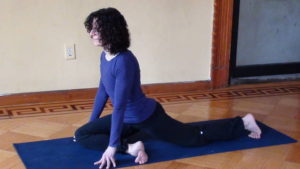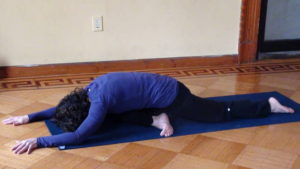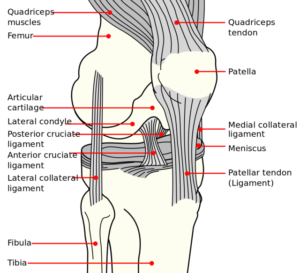Knee Pain in Pigeon Pose
Pigeon pose is one of my favorite poses. It is often a favorite pose of anyone with open hips.
Here is a basic description of how to do pigeon:
- Start on your hands and knees and slide your right knee forward and to the inside of your right wrist.
- The outside of the knee should line up with the outside of the hip.
- Slide your right leg back and tuck your right toes under (you can also point the foot if the foot and ankle are straight.
- You can keep your hands by your side and your spine upright, or, walk the hands and truck forward
- Stay in pigeon pose for 15 to 30 seconds, and then repeat with the opposite leg.
This is meant to be a piriformis muscle stretch.
The piriformis muscle stabilizes our hip joint by maintaining the ball at the top of the leg bone inside the acetabulum, or cup, of the hip bone.
It also contributes to the external rotation of the hip joint, as well abduction (pulling away) of the leg while in a flexed position.
If your hips are too open you might do pigeon and feel nothing. If the opposite is true you will feel the stretch deep in the butt.
And it won’t be fun.


Pigeon is a very common pose in yoga classes and unfortunately can have negative effects on the knee joint.
How deep you can go in pigeon pose is determined by how much rotation there is in the front hip socket.
The knee, shin, ankle, and foot should only go where the relative freedom of the ball and socket joints allow them to go.
There are many possible reasons for knee pain in pigeon pose but the pain often comes due to the alignment of the bones of the leg negatively affecting the ligaments of the knee.
The Knee Joint
Our knee is a hinge joint with very little play side to side.
The hinge needs to be maintained no matter how you place the leg in the pose.
If someone is open in the hips they can move the shin towards the front of the mat and maintain the strict hinge of the knee.
This is because the free range of the hip socket allows for it.
But any movement of the knee joint that puts negative pressure on the knee’s hinge is going to come at the expense of the knee’s ligaments creating knee pain in pigeon pose.
There are many ligaments both inside and outside of the knee capsule that are providing stability to the joint.

You have two ligaments on either side of the knee— the medial collateral and the lateral collateral ligaments.
You can actually feel these with your fingers and sense the effect that the disparate movements of your leg have on them.
Place your fingers on either side of the knee and begin to hinge your knee and flex your ankle. You should be able to feel these ligaments dancing around under your fingers.
The position of the foot and ankle also play a role in knee pain in the pigeon pose and you can use this simple experiment again in order to feel the effect of different foot positions.
With your fingers on either side of the knee, point or flex your foot and you should feel an even balance in the ligaments on either side of the knee.
But if you sickle (roll or turn it out) your foot and/or ankle you should feel that on one side the ligament will shorten while the other side lengthens.
I work with my foot flexed in pigeon for the most part but pointed is fine as well.
The thing that matters most is that the hinge of the knee and the balance of the ligaments are maintained.
The limitations of the hip and ankle joints will have a big effect on the depth of your pigeon pose and whether or not you will experience knee pain in pigeon pose.

